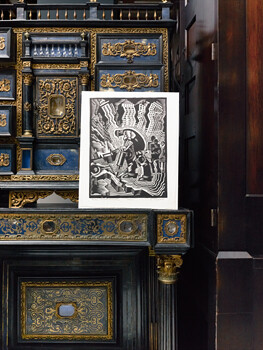December 3, 2012–April 7, 2013
The Wolfsonian–FIU
1001 Washington Ave.
Miami Beach, FL 33139
T 305 531 1001
F 305 531 2133
Commissioned and organized by the Wolfsonian–FIU.
Curated by Matthew Abess.
“With the end of the period represented in the Wolfsonian’s collection (1885–1945), the image of the worker fell out of favor as a subject for the arts. It made me think about how we do not know the faces of the people who create the things that surround us. We know other faces—politicians, celebrities, criminals—but not the worker, the one who makes and transforms.”
Conversation with Esther Shalev-Gerz, in Describing Labor publication, 2012
Commissioned by the Wolfsonian–Florida International University, Describing Labor draws on artist Esther Shalev-Gerz’s research into depictions of work and working figures from the late nineteenth through the mid-twentieth century. Once an icon of class consciousness and national character—widely portrayed in the period of the Russian Revolution, the Great Depression, and the two World Wars—the worker has since receded from the forefront of the visual field. Through new works of video, audio, and photography, Describing Labor gives image to the often unseen figure of the worker whose labor fabricates the physical world. Rather than glorify historic representations and rather than fetishize the figure of the worker, the project carries its visitor into a living image—the picturing of creation and of our own place within it.
Describing Labor comprises large format color photographs; a two-channel HD video installation; a selection of historic artworks; and an audio installation of recorded “voices” derived from the artworks and their era. The exhibition took form through a participatory process. Shalev-Gerz invited twenty-four people who have a mastery of the language around art—those who use the word as a tool when engaging with art—each to choose an historic artwork wherein workers appear and to describe it while being filmed. Through these faces and voices of the present day, the project engages with such dualities as the materiality of objects and the obstinacy of the image; the mediated gaze and the thing itself; historical moments and the current moment of recognition.
Visitors to the exhibition are invited to enter into this unfolding dialogue with mute images and their possible speech—with silent figures that might speak of their world and to our own provided we work to speak through them. Such is the sum and substance of description—of the effort to articulate persons, peoples, places, or moments that always elude articulation such that a community might form around and through the acts of seeing, saying, and listening.
Esther Shalev-Gerz is internationally recognized for an artistic practice that investigates the construction of knowledge, histories, and cultural identities. Her works frequently are developed in dialogue with the inhabitants of specific places or the witnesses to particular events, inviting people to become participants in discourses that address issues of representation, citizenship, and personal and collective memory.
Based in Paris, she is a professor in Fine Art at the Valand Academy at Göteborg University, Sweden, where she is currently leading an international research project on Trust and the Unfolding Dialogue, funded by the Swedish Research Council. Recent and forthcoming solo exhibitions include the Belkin Art Gallery, UBC, Vancouver (2013); Musée cantonal des Beaux-Arts, Lausanne, Switzerland (2012); Kamloops Art Gallery, Kamloops, British Columbia (2012); and Jeu de Paume, Paris (2010).
Publication
Esther Shalev-Gerz: Describing Labor
With new texts by Marianne Lamonaca and Jacques Rancière, and a conversation with the artist by Matthew Abess.
Hours: The museum is open daily from noon to 6pm; Friday from noon to 9pm; and closed on Wednesdays.
Admission: Admission is 7 USD for adults; 5 USD for seniors, students, and children age 6–12; and free for Wolfsonian members, State University System of Florida staff and students with ID, and children under six.
Press contact:
Maris Bish, Communications Manager: T 305 535 2622 / [email protected]
This project was made possible through the generous sponsorship of Gary L. Wasserman. Additional support received from the Adam Sender Charitable Trust; the Arthur F. and Alice E. Adams Foundation; and United Airlines, the Official Airline of The Wolfsonian–FIU.



